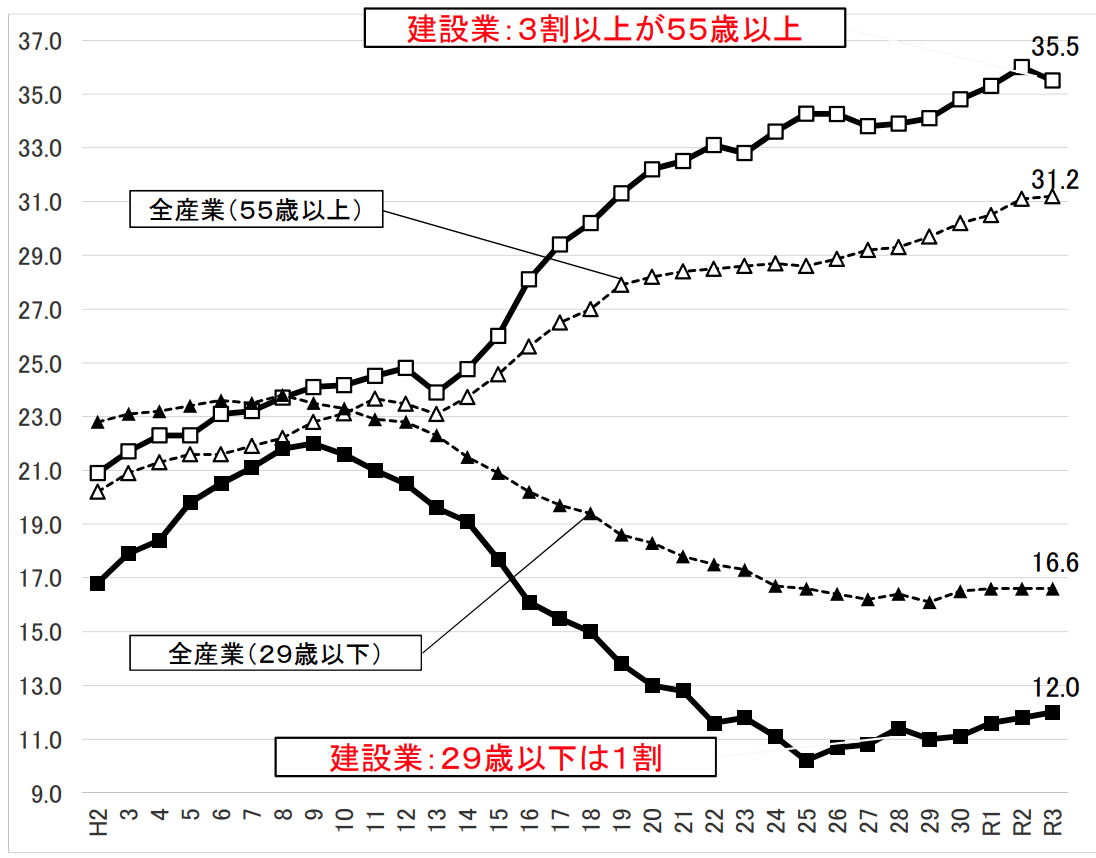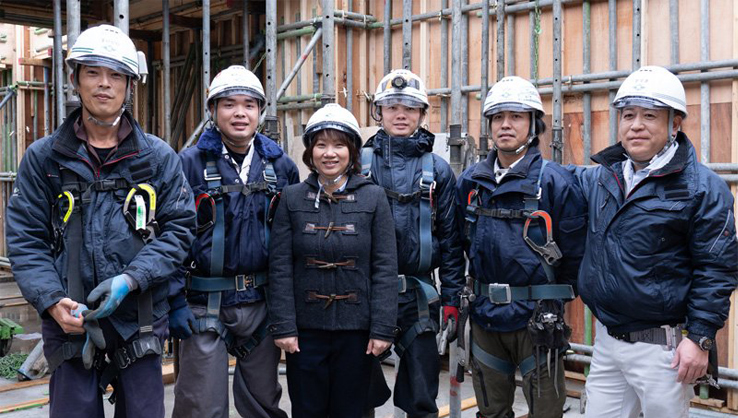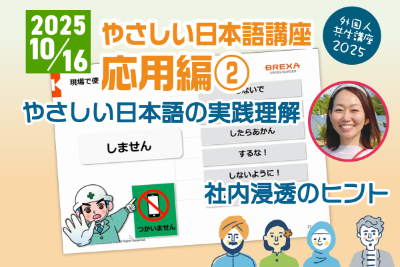- やさしい日本語
- ひらがなをつける
- Language
We provide multilingual content through machine translation. Translation accuracy is not 100%. About the multilingualization of the JAC website
- About JAC
- JAC Membership Information
- Specified Skilled Worker Acceptance
- Specified Skilled Worker Overview of the system
- 10 Mandatory Assistance for Foreigners
- Online individual consultation
- Seminar on Coexistence with Foreign Nationals
- Leading examples of host companies
- Case studies collection "Visionista"
- Foreigner's Voice
- Foreign Resident Acceptance Manual / Q&A
- Useful column "JAC Magazine"
- Acceptance support services
- Specified Skills Acceptance Support Service
- Health and Safety "Online Special Training"
- Safety and health “skills training”
- "Temporary Return Support" to ease the burden
- CCUS charge support
- Free Japanese language courses
- Education and Training Support
- Subsidy system for obtaining qualifications
- Support system for promoting the accumulation of employment history
- "Post-acceptance training" to deepen understanding of the system
- Compensation system for Specified Skilled Worker (i)
- freeJob matching
- The Specified Skills Evaluation Exam
- Home
- JAC Magazine
- The present and future of the construction industry
- Why is there a labor shortage in the construction industry? We'll also explain the countermeasures in detail!
- Home
- JAC Magazine
- The present and future of the construction industry
- Why is there a labor shortage in the construction industry? We'll also explain the countermeasures in detail!

Why is there a labor shortage in the construction industry? We'll also explain the countermeasures in detail!

Hello, this is Kano from JAC (Japan Association for Construction Human Resources).
The labor shortage in the construction industry is becoming more serious every year.
Why is this happening in the construction industry, which is an important part of social infrastructure?
Also, are there any measures to address the labor shortage?
This time, we will explain the causes of the labor shortage in the construction industry and solutions to it.
What is the current situation and reasons for the labor shortage in the construction industry?
According to a survey by the Ministry of Land, Infrastructure, Transport and Tourism titled "The Ministry of Land, Infrastructure, Transport and Tourism's Recent Situation Surrounding the Construction Industry," the number of construction industry employees peaked at 6.85 million in 1997, but fell by approximately 29% to 4.85 million in 2021.
*Source: Ministry of Land, Infrastructure, Transport and Tourism's recent report on the situation surrounding the construction industry
Construction investment peaked at 84 trillion yen in 1992 and is expected to fall by approximately 31% to 58.4 trillion yen in 2021. Although the amount of work in the construction industry itself is shrinking, the labor shortage remains a chronic problem.
The causes of the labor shortage include a decrease in the number of employees in the construction industry as a whole and an aging workforce, as well as a shortage of foreign workers due to the weak yen.
Decreasing number of workers in the construction industry as a whole and aging workforce
In particular, there has been a significant decline in the number of young employees, and according to the same Ministry of Land, Infrastructure, Transport and Tourism data, the proportion of construction industry employees aged 55 or over in 2021 was 35.5%, while those aged 29 or under were 12%, indicating that the industry is aging.
By the way, the proportion of people aged 55 or over in all industries is 31.2%, and the proportion of people aged 29 or under is 16.6%, so it is clear that there is a particular shortage of young people in the construction industry.

This also leads to the so-called "2025 problem."
The 2025 problem refers to the expected increase in social security costs, such as medical expenses and nursing care costs, as the baby boomers born during the first baby boom (1947-1949) reach the age of 75, or in other words, become elderly.
A 2021 survey found that the proportion of workers in the construction industry aged 55 and over is 35.5%, of which 25.7% are aged 60 and over.

Those aged 60 or over account for more than a quarter of the total population, and most of them are expected to be retired in 10 years' time.
Japan as a whole is already facing the problem of a declining young population.
In addition, with the spread of the Internet, there are now many different jobs available outside of the construction industry, which means more options available.
Although this is gradually improving through "work style reforms" and other measures, the construction industry still faces the problem of long working hours.
The total actual annual working hours in the construction industry are more than 340 hours longer than all other industries, and although this is shorter than about 20 years ago, the rate of decrease is smaller than all other industries, which is also a problem.
Shortage of foreign workers due to weak yen
The impact of the weak yen is serious not only in the construction industry, but also in Japan, which is accepting foreign workers to alleviate labor shortages.
The wages of foreign construction engineers in Japan have remained at around 200,000 yen per month in recent years, whereas in Vietnam, a country with many foreign workers coming from, the wages have risen to as high as 150,000 yen per month.
Due to the weak yen, wages in Japan have fallen significantly when converted into dollars.
As the wage gap between Japan and Vietnam narrows, the benefits of coming all the way to Japan to work are diminishing.
I have used Vietnam as an example, but similar trends can be seen in other countries.
Also check out the government's measures to solve the labor shortage in the construction industry!
In order to resolve the labor shortage in the construction industry, the Ministry of Land, Infrastructure, Transport and Tourism is promoting the simultaneous improvement of worker treatment, promotion of work style reform, and improvement of productivity.
1. Improving worker treatment
There is a perception that the work involves a lot of danger and that employment conditions are poor, so efforts are underway to dispel this image.
First of all, in the construction industry, where subcontracted work is common, there is a problem of many workers not being covered by social insurance.
Social insurance is a system that provides comprehensive coverage for illness, injury, and retirement.
Employees are obligated to enroll in social insurance, and companies are obligated to enroll their employees in social insurance.
While joining social insurance offers many benefits to workers, such as increased pensions, the ability to support family members, and the ability to receive survivor's pensions, the challenge is that it represents a heavy financial burden for companies, as half of the social insurance costs are paid by the company.
However, based on the idea that social insurance enrollment should be ensured in order to improve the treatment of workers, a system has been created in which construction companies that are not enrolled in social insurance will not be allowed to obtain or renew their construction business licenses.
In addition, with the aim of improving safety, efforts are being made to ensure that safety and health expenses are paid appropriately, and technical training, patrols, and individual instruction are being provided to create a system for working safely.
2. Promoting work style reform
"Work style reform" is being implemented throughout Japan to review the working environment.
This also includes correcting long working hours.
In order to solve the problem of long working hours, it is first necessary to set appropriate holidays.
The Ministry of Land, Infrastructure, Transport and Tourism has established a two-day weekend system as a rule for construction projects directly managed by the national government.
Setting appropriate construction periods is also important in order to work on a reasonable schedule.
The Central Construction Industry Council has created standards regarding construction periods, and it now requires that construction periods be broken down into smaller chunks and the number of days required be estimated.
If a construction period that is significantly shorter than the required period is set, the contract will be prohibited from being concluded, and any violation will result in a warning.
In addition, in order to secure a wide range of human resources, efforts are being made to make it easier for young people and women to work by promoting flexible working styles that take childbirth and childcare into consideration, as well as increasing subsidies for training expenses and wages for young and female workers.
3. Increased Productivity
Improving productivity also leads to improvements in long working hours.
The working population is declining throughout Japan, and considering that the labor shortage will remain an issue for the foreseeable future, improving productivity can be said to be an urgent task.
In order to improve productivity, the first thing we need to do is make effective use of our limited human resources.
Next, we will promote digital transformation, such as utilizing ICT construction machinery and tools.
Labor shortages can be alleviated by entrusting tasks that do not require human intervention to machines and tools.
By utilizing drones and robots, it is possible to reduce the risk of engaging in dangerous work and obtain highly accurate data.

Labor shortages can be alleviated by entrusting tasks that do not require human intervention to machines and tools.
By utilizing drones and robots, it is possible to reduce the risk of engaging in dangerous work and obtain highly accurate data.
It may be difficult to introduce large machinery and systems due to the high costs involved, but it would be a good idea to start by doing things that will help keep costs down, such as holding meetings online.
This reduces travel time for meetings, and if you record the meetings, you can review them later.
Introducing actual examples of measures to address the labor shortage in the construction industry
Many construction companies are working to address the labor shortage.
Let me introduce a few of them.
[Measure example 1] Labor saving through the use of technology
Simple tasks that involve a large burden, such as transporting materials, are automated by introducing robots.
This is an example of how valuable labor resources can be allocated to other tasks and the risk of injury is reduced.
At the site, communication and management is carried out using ICT devices, which has made operations smoother and has also succeeded in establishing an appropriate management system.
[Measure Example 2] Increase opportunities for women to play active roles
A team of female staff members was formed to handle the inspection process, enabling more detailed checks.
By introducing childcare leave and flextime systems that can be used by both men and women, we have created an environment where employees can work while also caring for housework, childcare, and elderly care.
[Measure Example 3] Develop and assign human resources across departmental boundaries
While assigning employees to departments such as materials, construction, civil engineering, auditing, and sales will hone their expertise, it has the disadvantage of causing disparity in work due to workload.
Therefore, we implemented flexible personnel placement and training across departments.
We also provide qualification allowances and promote the development of human resources with multifaceted knowledge and experience.
[Countermeasure example (4)] Accept Specified Skilled Worker
"Specified Skills" was established as a new status of residence by the revised Immigration Control Act passed and enacted in 2018 with the aim of solving the shortage of human resources in Japan.
It has been available since April 2019.
The introduction of Specified Skills requirement has made it possible for foreign workers to work in sectors where there is a significant labor shortage, including the construction sector.
By embracing this Specified Skilled Worker, more and more companies are retaining talent.
Specified Skills require a certain level of expertise, skills, and Japanese language ability.
In other words, you will be able to work as an immediate asset.
If you have completed Technical Intern Training (ii) well, you can also change your status of residence from Technical Intern Training to Specified Skills.
As a result, it is now possible to extend the period of stay to work and bring back and hire Technical Intern Training graduates who have returned to their home countries.
Please refer to the "Overview of the Specified Skilled Worker System" for a detailed explanation of Specified Skills.
Specified Skilled Worker Outline of the system
Japan had strict entry restrictions on foreigners during the COVID-19 pandemic, but as the movement to relax these restrictions is accelerating, we can expect to see more employment opportunities in the future.
Summary: Measures to address the labor shortage in the construction industry are urgent! Let's consider measures based on examples
With a labor shortage across Japan, the problem is particularly evident in the construction industry.
In addition to the labor shortage, there is also the problem of an aging population, with a quarter of those working in the construction industry being over 60 years old.
Reasons for the labor shortage include an increase in job options outside of the construction industry and the weakening of the yen, which has eroded the wage benefits for foreign workers.
Measures to resolve the labor shortage include improving worker treatment, promoting work style reforms to eliminate long working hours, and improving work efficiency.
In fact, many companies are already taking various initiatives, and there seem to be many cases where improvements have been beneficial not only for workers but also for companies.
One way to secure talent is to hire Specified Skilled Worker.
Specified Skills is one of the status of residence, but it is a condition that you have certain skills and Japanese abilities, so you can accept it as an immediate force.
If you are a company that is considering accepting Specified Skilled Worker in the construction industry, please feel free to contact JAC!
*This column was written based on information from December 2022.
I wrote the article!

Japan Association for Construction Human Resources Manager, Management Department (and Research Department)
Motoko Kano
Cano Motoko
Born in Aichi Prefecture.
He is in charge of public relations, research and investigation, and is the person behind social media.
We update our social media accounts daily with the desire to make people fall in love with Japan, to spread the appeal of construction from Japan to the world, and to ensure that Japan's construction industry continues to be the industry of choice around the world.
He is also engaged in research into the feasibility of implementing skills evaluation exam in Asian countries, and is conducting interviews with local organizations in each country.




















